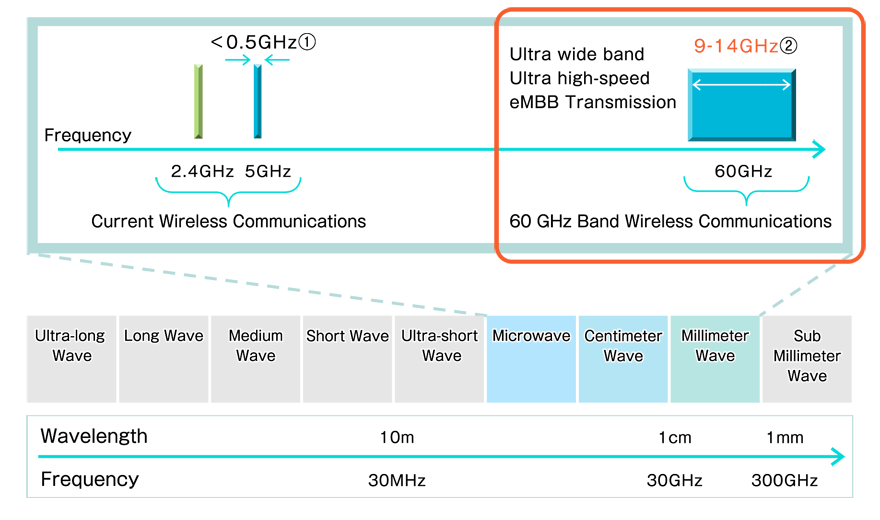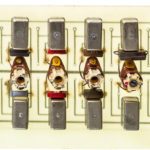The millimeter band spans from 30 to 300 gigahertz (GHz) and lies between the super high-frequency and far infrared bands, the lower part of which is the terahertz band. Radio waves in this band have wavelengths from ten to one millimeter; thus, radiation in this band is called millimeter waves, sometimes abbreviated MMW or mmWave. The International Telecommunication Union (ITU) designation for this band of radio frequencies is “extremely high frequency” (EHF).
There are several uses for mmWaves, including communications, short-range radar, sensors, and airport security scanners. Various portions of the mmWave band are being used in applications such as:
- The ITU non-exclusive passive frequency allocation at 57- to 59.3-GHz is used for atmospheric monitoring in meteorological and climate sensing applications and is important for these purposes due to the properties of oxygen absorption and emission in Earth’s atmosphere.
- IEEE 802.15 wireless personal area networks (WPAN) defined to operate in the 57- to 66-GHz range.
- IEEE 802.16 wireless metropolitan area network (WMAN), also known as WiMAX (Worldwide Interoperability for Microwave Access), is defined as operating in the 10- to 66-GHz band.
- IEEE 802.11ad multiple gigabit wireless system (MGWS) at 60 GHz.
- 5G cellular telecommunications in the 24- to 39-GHz bands.
- Millimeter wave radar is used in short-range fire-control radar in tanks and aircraft and automated guns on naval ships to shoot down incoming missiles.
- Traffic police use speed-detecting radar guns in the Ka-band (33.4- to 36.0-GHz).
- Clothing and other organic materials are transparent to millimeter waves of certain frequencies. A recent application has been scanners to detect weapons and other dangerous objects carried under clothing for applications such as airport security.
mmWave attenuation has minuses and a plus
mmWave propagates solely by line-of-sight paths. The ionosphere does not reflect them, nor do they travel along the Earth as ground waves as lower frequency radio waves do. At typical power densities, they are blocked by building walls and suffer significant attenuation passing through foliage. Absorption by atmospheric gases is a significant factor throughout the band and increases with frequency. However, it is maximum at a few specific absorption lines, mainly oxygen at 60 GHz and water vapor at 24 GHz and 184 GHz. At frequencies in the “windows” between these absorption peaks, mmWaves have much less atmospheric attenuation and greater range, so many applications use these frequencies. However, mmWaves still suffer from line-of-sight propagation and other limitations.

Raindrops are about the same size as mm wavelengths, so precipitation causes additional attenuation due to scattering (called rain fade) as well as absorption. The high free space loss and atmospheric absorption greatly limit useful propagation. That is a plus for developing high-density communications networks, such as 5G and WPANs, since it supports improved spectrum utilization through frequency reuse over relatively small geographic areas.
The high bandwidth and short transmission distances of mmWave also make it useful for applications such as short-distance wireless transmission of ultra-high-definition video and communications from small, low-power IoT devices. The limited propagation distance and high data rates are expected to make mmWave useful for communications between autonomous vehicles.

mmWaves and 5G
Given mmWaves’ capabilities to deliver low-latency, high-bandwidth communications over short distances, the ITU has defined the following three main usage scenarios for 5G:
- Enhanced Mobile Broadband (eMBB) to deal with hugely increased data rates, high user density, and very high traffic capacity for hotspot scenarios and seamless coverage and high mobility scenarios with still improved data rates. eMBB can support several sub-use cases including cloud office/gaming, virtual/augmented reality (VR/AR) and three-dimension/ultra-high-definition (3D/UHD) video.
- Massive Machine-type Communications (mMTC) for the IoT, requiring low power consumption and low data rates for very large numbers of connected devices. mMTC can provide long-range communication with energy efficiency and asynchronous access. Such features are very suitable for low-power devices in a massive quantity.
- Ultra-reliable and Low Latency Communications (URLLC) to cater to safety-critical and mission-critical applications, such as industrial automation and robotics, autonomous driving, drone-based delivery, and remote medical assistance.

The proposed agile 5G frame structure shows promising results for URLLC latency requirements by utilizing different transmission time intervals (TTIs) for URLLC and eMMB to meet their desired spectral efficiencies (SE). For example, URLLC traffic can be scheduled on a smaller TTI duration to achieve its low latency goal, and eMBB traffic can be scheduled with a long TTI duration to maintain its extreme SE requirements.
URLLC-focused applications require an end-to-end data delivery with reliability, security, and minimum latency supported by mmWave technology. The ITU set specific quality of service (QoS) requirements such as an air interface latency of 1 ms and 99.999% system reliability for URLLC. These QoS requirements for URLLC for selected applications are shown below:

While this FAQ focused on mmWaves, 5G consists of two separate frequency bands; FR1 is mostly repurposed LTE bands and FR2 bands in the mmWave region. As a result, 5G in the FR1 frequencies can RF architectures like those currently used in LTE cell phones, Bluetooth, and similar devices. The FR1 section of 5G devices will be able to use similar RF modulation/demodulation architectures, and similar analog front ends. They won’t be identical because 5G will have more bandwidth than LTE. But the increased bandwidth can be accommodated with quite similar technologies. Part two of this three-part FAQ series will consider, “What is the 5G RF/mmWave signal chain?” The series will conclude with a look into “mmWave antennas and antenna management for 5G.”
References:
5G Ultra-Reliable Low-Latency Communication Implementation Challenges and Operational Issues with IoT Devices, MDPI
Extremely high frequency, Wikipedia
mmWave Realizes Gigabit-class High-speed Telecommunications, Fujikura
mmWave sensors, Texas Instruments





